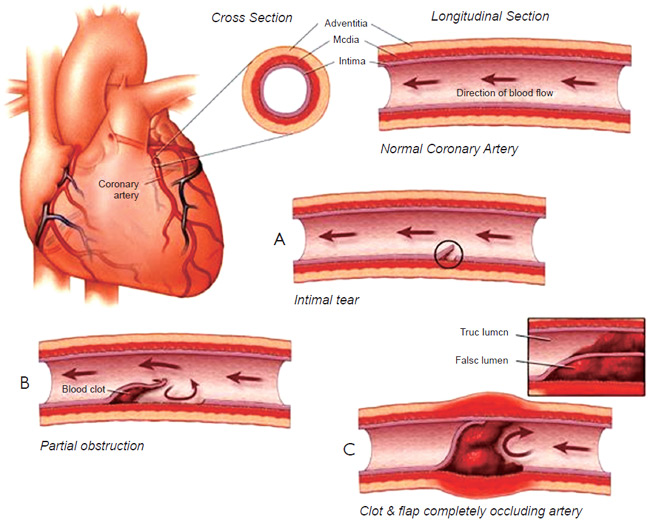Spontaneous Coronary Artery Dissection (SCAD): A Rare Heart Condition in Women

A coronary artery dissection (also known as spontaneous coronary artery dissection, or SCAD) is a rare, sometimes fatal traumatic condition, with eighty percent of cases affecting women. The coronary artery develops a tear in the inner lining called tunica intima, causing blood to flow between the layers which forces them apart. This allows blood to penetrate and cause an intramural hematoma (a localized collection of blood outside the blood vessels) in the central layer, the tunica media, and a restriction in the size of the lumen, resulting in reduced blood flow which in turn causes myocardial infarction and can later cause sudden cardiac death.
Early studies of the disease placed mortality rates at around 70%, but more recent evidence suggests a figure of around 20%. The condition is often seen to be related to female hormone levels, as well as other pre-existing cardiovascular conditions. In addition to this, a dissection can occur iatrogenically, by the surgical insertion of a catheter into the coronary artery.
According to the latest statistics, approximately 42 million American women live
with some form of cardiovascular
disease,
and many are still unaware of the risks they face. One of the least recognized
cardiovascular-related conditions is called spontaneous coronary artery
dissection - or SCAD. Most people probably have never heard of the condition,
but it poses a real threat. SCAD occurs when two of the three layers in the
coronary artery separate, causing blood to enter the space between the layers.
The blood tracks down the layers, "dissecting" its way along the artery. This
can result in a partial or complete blockage, causing chest pain, a heart attack
or sudden cardiac death.
One of the least recognized cardiovascular-related conditions is called spontaneous coronary artery dissection - or SCAD. Most people probably have never heard of the condition, but it poses a real threat. SCAD occurs when two of the three layers in the coronary artery separate, causing blood to enter the space between the layers. The blood tracks down the layers, "dissecting" its way along the artery. This can result in a partial or complete blockage, causing chest pain, a heart attack or sudden cardiac death.

SCAD & Women at Risk
Women are more susceptible to SCAD than men, with approximately 70 percent to 75
percent of the cases occurring in women age 50 or younger. Patients with SCAD
are relatively young (42.6 years old on average) and the vast majority are women
(82 percent). Those who develop SCAD are typically between the ages of 30 and
50. Pregnant women are at increased risk for SCAD. In fact, about 30 percent of
SCAD cases in women occur during the final trimester or after childbirth.
There is no conclusive evidence as to why pregnant women are at higher risk for
SCAD, although some believe changes in blood vessels, sex hormones and blood
volume are the main reasons.
An inflammatory reaction is almost always the underlying common denominator. A condition that affects mostly women called fibromuscular dysplasia (in which arteries become narrowed due to accumulations of cells on the artery wall) also seems to be a risk factor for SCAD.
Recent studies suggest that SCAD can affect anyone - even those who consider
themselves fit and healthy or do not have risk factors for coronary artery
disease. Ongoing research suggests that the condition is more common than
previously thought. Some researchers now believe that many previous heart
attacks attributed to cholesterol blockages
may have been due to SCAD instead.
Causes
There
is evidence to suggest that a major cause of spontaneous coronary artery
dissection (SCAD) is related to female hormone levels, as most cases appear to
arise in pre-menopausal women, although there is evidence that the condition can
have various triggers; other underlying conditions such as hypertension may
sometimes be causes. There is also a possibility that exercise can
be a trigger. However cases sometimes have no obvious cause.

Signs and symptoms
The symptoms are often very similar to those of myocardial infarction (heart attack), with the most common being persistent chest pain.
Diagnosis
To properly diagnose SCAD, a physician may use advanced imaging tests, like a
coronary angiogram or CT angiography, to get a better view of your coronary
arteries.
Coronary artery problems are usually detected by an angiogram. But SCAD might not be visible on an angiogram because, although the test will clearly identify a narrowing or blockage in the artery, it does not allow physicians to see the actual vessel walls or their structure. "For this reason, it can be easy to wrongly attribute this narrowing to cholesterol buildup because, of course, that's still the most common cause of heart attack," Dr. says. "Fortunately, newer imaging tools in the catheterization lab are allowing us to distinguish between plaque build-up and dissection or the disruption of the vessel wall itself.
Treatment
Treatment is varied including monitoring, medications, angioplasty or bypass
surgery. In severe cases, coronary artery bypass surgery is performed to
redirect blood flow around the affected area. Drug-eluting stents and
thrombolytic drug therapy are less invasive options for less severe cases.
- http://www.invasivecardiology.com/
-
http://www.mayoclinic.org/
- http://www.wane.com/
- http://www.dailymail.co.uk/
